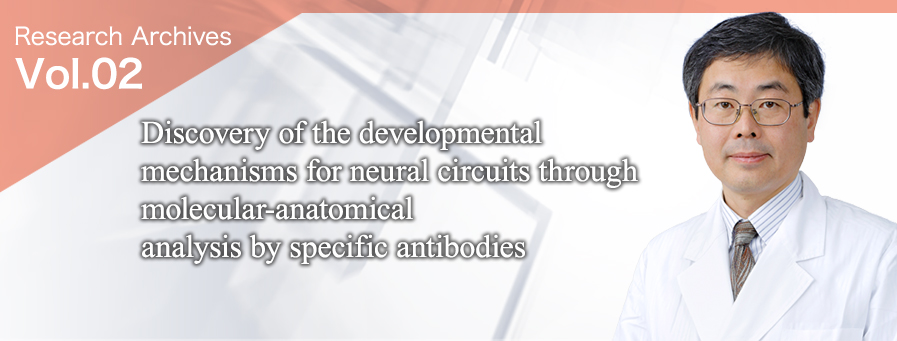
Department of Anatomy and Embryology, Graduate School of Medicine, Hokkaido University
Masahiko Watanabe, M.D., Ph.D.Physiological
Science
- 1984: Graduated from Tohoku University School of Medicine, degree earned MD.
- 1988: Completed the Doctoral Program of the University of Tsukuba Graduate School of Medicine, degree earned MD-PhD.
- 1988: Research Associate, Anatomy 1, Kanazawa University School of Medicine
- 1990: Research Associate, Anatomy 2, Tohoku University School of Medicine
- 1992: Assistant Professor, Anatomy 1, Hokkaido University School of Medicine
- 1993-1994 Appointed as a researcher of The Ministry of Education of Japan at the University of North Carolina
- 1998-Present: Professor, Hokkaido University Graduate School of Medicine
Developed more than 200 kinds of specific antibodies
Also made a world first discovery in research on synapse circuit development
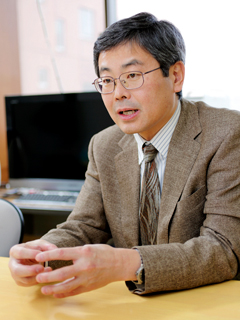
The Department of Anatomy and Embryology led by Professor Masahiko Watanabe has conducted research into molecular anatomy including the excitatory synaptic transmission essential for higher brain functions. For more than thirty years Professor Watanabe has been engaged in the development of antibodies essential to detect molecules and visualize specific types of tissue and cells which express the molecules of interest, and has developed more than 200 molecule specific antibodies. The Department of Anatomy and Embryology is pursuing innovative neural molecular-anatomical research using these antibodies.
"Our main research theme is mechanisms for synaptic circuit development. At the development stage, synaptic circuits are crowded together and overlap, and they will become elaborated by receiving stimuli from the outside. At the molecular level our research looks into how neural circuits will be changed by stimuli and how they will be affected when signal transduction is not functioning properly."
The lab has been engaged in experiments and verification of (1) analysis of the location of expression of the glutamate receptor which is important in the signal transduction, and (2) abnormal development of the motor function in receptor-deficient mice by focusing on cerebellar Purkinje cells.
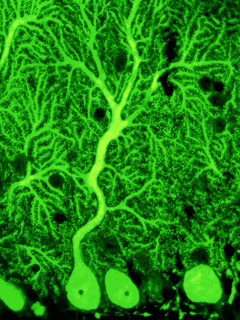
"In the first of the two themes above, we are examining the precise location of the glutamate receptor in the neural circuit by using the antibodies of molecules involved in the transmission of glutamate. For the second, we have examined the kinds of abnormal development that occur if the receptor is lost, and our aim is to elucidate the role the transmission of glutamatergic signaling in the development of neural circuits by integrating the findings of the two lines of research."
"Neuronal circuits develop in a balanced manner when subject to multiple inputs. If either of these influences becomes dominant (or weak), normal neural circuits will be destroyed. If such unbalance occurs in Purkinje cells, this will give rise to abnormalities in cerebellar function, i.e., motor ataxia. This research is the first in the world to demonstrate, at the electron microscopic level, that two types of excitatory synaptic circuits on Purkinje cells are mutually competitive."
A research theme that requires advanced expertise and experience, and this is why we find it worth devoting our lives to this research.
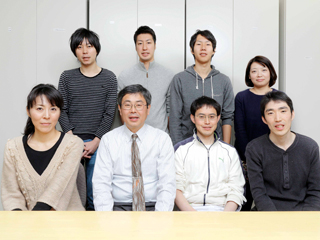
The Department of Anatomy and Embryology has a large staff with experience in advanced morphological analytic techniques and is conducting a variety of studies exploring neural molecular-anatomical mechanisms related to the development of neural circuits and the expression of genes and molecules underlying neural functions. The main lines of research include "Development of specific antibodies for expression analysis of molecules", 'Control of neurotransmitter receptor expression", "Expression and function analyses of the glutamate receptor, GluD family", and "Molecular anatomy of control of the neurotransmitter system". These studies are carried out by cutting-edge technologies such as in situ hybridization (ISH), which is necessary for gene expression analysis and morphological analysis of neurons, immunohistochemistry, electron microscopy, and neural morphology.
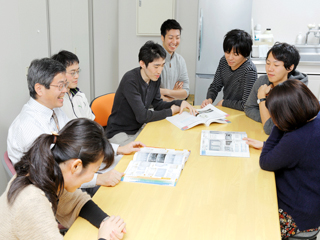
"Our research field requires very advanced, extensive knowledge and experience, and it may take five to ten years to become a full-fledged researcher, and sometimes a few years to complete one paper. Therefore, it is a very challenging field. However, for all its difficulty, we find it worthwhile to devote our lives to this pursuit and we gain important internationally acclaimed results. The faculty of medicine offers you opportunities to study all aspects of human beings, one of the animals of the earth, at all levels of magnification, the molecular, physiological, pathological, and clinical levels. You can pursue your interest to any depth while gaining a bird's-eye-view and understanding. Our society is seeking such researchers, and it is one of our important missions to train researchers who will play a leading role in the bioscience of the future."
(Interviewed in November 2013)
"Imoni" party enjoying communication and local specialties of Yamagata prefecture
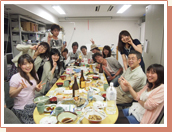 At our lab, the students who have finished the anatomy training under Professor Watanabe hold "Imoni" parties several times a year. "Imoni" is a traditional dish of Yamagata, Professor Watanabe's birth place. At the party Professor Watanabe cooks "Imoni", the main dish, and students bring other food and drinks. This is a very enjoyable and casual party that strengthens the ties between professors, staff, and students while engaging in communication around the dishes.
At our lab, the students who have finished the anatomy training under Professor Watanabe hold "Imoni" parties several times a year. "Imoni" is a traditional dish of Yamagata, Professor Watanabe's birth place. At the party Professor Watanabe cooks "Imoni", the main dish, and students bring other food and drinks. This is a very enjoyable and casual party that strengthens the ties between professors, staff, and students while engaging in communication around the dishes.


